Haryana State Board HBSE 9th Class Maths Solutions Chapter 9 Areas of Parallelograms and Triangles Ex 9.3 Textbook Exercise Questions and Answers.
Haryana Board 9th Class Maths Solutions Chapter 9 Areas of Parallelograms and Triangles Exercise 9.3
Question 1.
In figure 9.23, E is any point on median AD of a ΔABC. Show that ar (ABE) = ar (ACE).
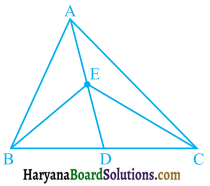
Solution:
In ΔABC, AD is a median and median divides a triangle into two triangles of equal areas.
∴ ar (ΔABD) = ar (ΔACD) …(i)
Again, in ΔEBC, ED is a median.
∴ ar (ΔEBD) = ar (ΔECD) …(ii)
Subtracting (ii) from (i), we get
ar (ΔABD) – ar (ΔEBD) = ar (ΔACD) – ar (ΔECD)
⇒ ar (ΔABE) = ar (ΔACE).
Hence proved
Question 2.
In a triangle ABC, E is the mid point of median AD. Show that ar (BED) = \(\frac{1}{4}\)ar (ABC).
Solution:
Since AD is a median of AABC and median divides a triangle into two triangles of equal areas.
∴ ar (ΔABD) = ar (ΔACD)
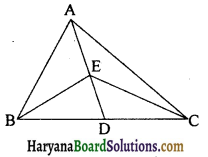
⇒ ar (ΔABD) = \(\frac{1}{2}\)ar (ΔABC) …(i)
In ΔABD, BE is the median.
ar (ΔBED) = ar (ΔBAE)
ar (ΔBED) = \(\frac{1}{2}\)ar (ΔABD)
ar (ΔBED) = \(\frac{1}{2} \times \frac{1}{2}\)ar (ΔABC) [using (i)]
ar (ΔBED) = \(\frac{1}{4}\)ar (ΔABC).
Hence proved
![]()
Question 3.
Show that the diagonals of a parallelogram divide it into four triangles of equal area.
Solution:
Given: A parallelogram ABCD in which diagonals AC and BD intersect at O.
Prove : ar (ΔAOB) = ar (ΔBOC) = ar (ΔCOD) = ar (ΔDOA).
Proof : Since, diagonals of a parallelogram bisect each other.
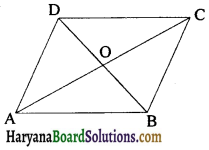
OA = OC and OB = OD and a median divides the triangle into two triangles of equal areas.
Now in ΔABC, BO is the median.
ar (ΔAOB) = ar (ΔBOC) …..(i)
In ΔBCD, CO is the median.
ar (ΔCOD) = ar (ΔBOC) ……(ii)
In ΔCDA, DO is the median.
ar (ΔCOD) = ar (ΔAOD) …..(iii)
From (i), (ii) and (iii),
we get ar (ΔAOB) = ar (ΔBOC)
= ar (ΔCOD) = ar(ΔAOD)
Hence proved
Question 4.
In figure 9.24, ABC and ABD are two triangles on the same base AB. If line segment CD is bisected by AB at 0, show that ar (ABC) = ar (ABD).
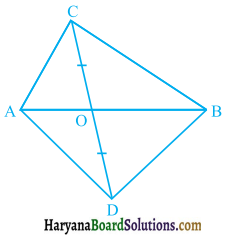
Solution:
In ΔACD, we have
OC = OD [∵ given line CD is bisected by AB]
∴ AO is the median.
⇒ ar (AOC) = ar (AOD) …(i)
[median divides a A in two As of equal areas]
Similarly, in ΔBCD, BO is the median.
⇒ ar(BOC) = ar (BOD) ….(ii)
Adding (i) and (ii), we get
ar (AOC) + ar (BOC) = ar (AOD) + ar (BOD)
⇒ ar (ABC) = ar (ABD).
Hence proved
![]()
Question 5.
D, E and F are respectively the mid points of the sides BC, CA and AB of a ΔABC. Show that
(i) BDEF is a parallelogram
(ii) ar (DEF) = \(\frac{1}{4}\)ar (ABC)
(iii) ar (BDEF) = \(\frac{1}{2}\)ar (ABC).
Solution:
Given : A triangle ABC in which D, E and Fare the mid points of the sides BC, CA and AB respectively.

To prove : (i) BDEF is a parallelogram.
(ii) ar (DEF) = \(\frac{1}{4}\)ar (ABC)
(iii) ar (BDEF) = \(\frac{1}{2}\)ar (ABC).
Proof : (i) In ΔABC, F and E are the mid points of the sides AB and AC respectively.
∴ FE || BC and FE = \(\frac{1}{2}\)BC
⇒ FE || BD and FE = BD [∵ D is the mid point of BC, ∴ BD = CD]
∴ BDEF is a parallelogram.
(ii) Similarly, F and D are the mid points of the sides AB and BC respectively.
∴ FD || AC and FD = \(\frac{1}{2}\)AC
∴ FD || EC and FD = \(\frac{1}{2}\)AC
⇒ FD || EC and FD = EC
∴ FDCE is a parallelogram.
Similarly, we can prove that AFDE is a parallelogram.
Since, FD is a diagonal of parallelogram BDEF
∴ ar(FBD) = ar (DEF) …(i)
[∵ a diagonal divides a || gm into two Δs of equal areas]
Similarly, DE is a diagonal of parallelogram FDCE.
∴ ar(ECD) = ar (DEF) …(ii)
and FE is a diagonal of parallelogram AFDE.
∴ ar (AFE) = ar (DEF) …(iii)
From (i), (ii) and (iii), we have
ar (FBD) = ar (DEF) = ar (ECD)
= ar (AFE) …..(iv)
Now, ar (FBD) + ar (DEF)+ ar (ECD) + ar (AFE) = ar (ABC)
⇒ ar (DEF) + ar (DEF)+ ar (DEF) + ar (DEF)
= ar (ABC) [using (iv)]
⇒ 4 ar (DEF) = ar (ABC)
⇒ ar (DEF) = \(\frac{1}{4}\)ar (ABC)
(iii) ar (DEF) = \(\frac{1}{4}\) a ar (ABC)
(as proved above)
2 ar (DEF) = \(\frac{2}{4}\)ar (ABC)
⇒ ar (DEF) + ar (DEF) = \(\frac{1}{2}\)ar (ABC)
⇒ ar (DEF) + ar (FBD) = \(\frac{1}{2}\)ar (ABC) [using (i)]
⇒ ar (BDEF) = \(\frac{1}{2}\)ar (ABC).
Hence proved.
Question 6.
In figure 9.25, diagonals AC and BD of quadrilateral ABCD intersect at O such that OB = OD. If AB = CD, then show that:
(i) ar (DOC) = ar (AOB)
(ii) ar (DCB) = ar (ACB)
(iii) DA || CB or ABCD is a parallelogram
[Hint : From Dand B, draw perpendiculars to AC]
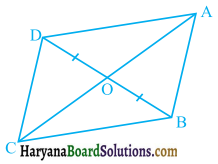
Solution:
(i) Draw BM ⊥ AC and DN ⊥ AC.
In ΔDON and ΔBOM, we have
∠DNO = ∠BMO (Each = 90°)
∠DON = ∠BOM
(vertically opposite angles)
and DO = OB (given)
∴ ΔDON ≅ ΔBOM
(By AAS congruecne rule)
⇒ ar (DON) = ar (BOM) ……(i)
⇒ DN = BM (CPCT)
In ΔDCN and ΔBAM, we have
∠DNC = ∠BMA (Each = 90°)
Hyp. DC = Hyp. AB (given)
and DN = BM (as proved above)
∴ ΔDCN ≅ ΔBAM (By RHS congruence rule)
⇒ ar (DCN) = ar (BAM) …(ii)
Adding (i) and (ii), we get
ar (DON) + ar (DCN) = ar (BOM) + ar (BAM)
⇒ ar (DOC) = ar (AOB).
(ii) ar (DOC) = ar (AOB)
⇒ ar (DOC) + ar(COB) = ar (AOB) + ar (COB)
(Adding ar (COB) on both sides)
⇒ ar (DCB) = ar (ACB).
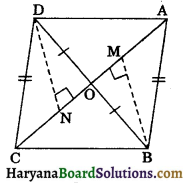
(ii) Since ΔDCB and ΔACB are on the same base BC and have equal areas.
∴ DA || CB
Now, ΔDON ≅ ΔBOM (as proved above)
∠ODN = ∠OBM(CPCT) … (iii)
ΔDCN ≅ ΔBAM (as proved above)
⇒ ∠CDN = ∠ABM (CPCT) …(iv)
Adding (iii) and (iv), we get
∠ODN + ∠CDN = ∠OBM + ∠ABM
⇒ ∠ODC = ∠OBA
But these are alternate interior angles.
∴ CD || AB
∴ ABCD is a parallelogram. Hence proved
![]()
Question 7.
D and E are points on sides AB and AC respectively of SABC such that ar (DBC) = ar (EBC). Prove that DE || BC.
Solution:
Since ΔDBC and ΔEBC are on the same base BC and have equal areas.
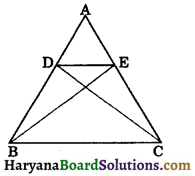
Therefore ΔDBC and ΔEBC lie between the same parallels.
∴ DE || BC. Hence proved
Question 8.
XY is a line parallel to side BC of a triangle ABC. If BE || AC and CF || AB meet XY at E and F respectively, show that:
ar (ABE) = ar (ACF).
Solution:
XY || BC and EB || YC [∵ BE || AC]
∴ BCYE is a parallelogram.
Again, XY || BC and BX || CF. [∵ AB || CF]
BCFX is a parallelogram.
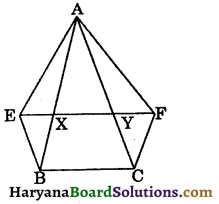
Since ΔABE and parallelogram BCYE are on the same base EB and between the same parallels EB and AC.
∴ ar (ABE) = \(\frac{1}{2}\)ar (BCYE) …(i)
Similarly, ΔACF and parallelogram BCFX are on the same base CF and between the same parallels CF and AB.
∴ ar (ACF) = ar (BCFX) ……(ii)
and parallelograms BCYE and BCFX are on the same base BC and between the same parallels BC and EF.
∴ ar(BCYE) = ar (BCFX) …(iii)
From (i), (ii) and (iii), we have
ar (ABE) = ar (ACF).
Hence proved.
Question 9.
The side AB of a parallelogram ABCD is produced to any point P. A line through A and parallel to CP meets CB produced at Q and then parallelogram PBQR is completed (see figure 9.26). Show that ar (ABCD) = ar (PBQR).

Solution:
Join AC and PQ.
Since ΔAQC and ΔAQP are on the same base AQ and between the same parallels AQ and CP.
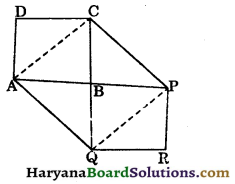
ar (ΔAQC) = ar (ΔAQP)
⇒ ar (ΔAQC) – ar (ΔABQ) = ar (ΔAQP) – ar (ΔABQ)
⇒ ar (ΔABC) = ar (ΔPBQ)
⇒ \(\frac{1}{2}\)ar (||gm ABCD) = \(\frac{1}{2}\)ar (||gm PBQR) [∵ a diagonal divides the ||gm into two Δs of equal areas)
⇒ ar (||gm ABCD) = ar (||gm PBQR).
Hence proved
![]()
Question 10.
Diagonals AC and BD of a trapezium ABCD with AB || DC intersect each other at O. Prove that ar (AOD) = ar (BOC).
Solution:
In a trapezium ABCD,
we have AB || CD
So, ΔABC and ΔABD are on the same base AB and between the same parallels AB and CD.
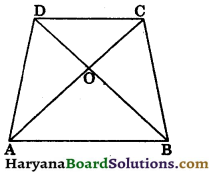
∴ ar (ΔABC) = ar (ΔBAD) (by theorem 9.2)
⇒ ar (ΔABC) – ar (ΔAOB) = ar (ΔBAD) – ar (ΔAOB)
⇒ ar (ΔBOC) = ar (ΔAOD).
Hence proved.
Question 11.
In figure 9.27, ABCDE is a pentagon. A line through B parallel to AC meets DC produced at F. Show that:
(i) ar (ACB) = (ar ACF)
(ii) ar (AEDF) = ar (ABCDE).
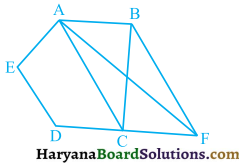
Solution:
(i) Since ΔACB and ΔACF are on the same base AC and between the same parallels AC and BF.
∴ ar(ACB) = ar (ACF)
(ii) ar (ACB) = ar (ACF) (as proved above)
⇒ ar (ACB) + ar (ACDE) = ar (ACF) + ar (ACDE)
[Adding ar (ACDE) on both sides]
⇒ ar (ABCDE) = ar (AEDF)
⇒ ar (AEDF) = ar (ABCDE). Hence proved
Question 12.
A villager Itwaari has a plot of land of the shape of a quadrilateral. The Gram Panchayat of the village decided to take over some portion of his plot from one of the corners to construct a Health Centre. Itwaari agrees to the above proposal with the condition that he should be given equal amount of land in lieu of his land adjoining his plot so as to form a triangular plot. Explain how this proposal will be implemented.
Solution:
Let ABCD be the plot of land of villager Itwaari and the Gram Panchayat decided to take some portion of land from corner D (say) of the plot ABCD. Since Itwaari wants to have equal amount of land in the lie of land COD we may proceed it as follows:
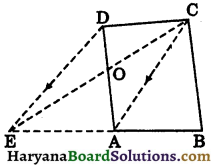
Join AC and draw a line through D parallel to AC to meet BA produced at E. Join EC intersects AD at O.
Now, ΔACD and ΔEAC are on the same base AC and between the same parallels AC and DE.
∴ ar (ΔACD) = ar (ΔEAC)
⇒ ar (ΔACD) – ar (ΔAOC) = ar (EAC) – ar (ΔAOC)
⇒ ar (COD) = ar (ΔAOE) ……(i)
Now, ar (quad. ABCD) = ar (quad. OABC) + ar (ΔCOD)
⇒ ar (quad. ABCD)= ar (quad. OABC) + ar (ΔAOE) [using (i)]
⇒ ar(quad. ABCD) = ar (ACEB)
So, the Gram Panchayat take area (ΔCOD) and provided ar (ΔAOE) to the Itwaari.
![]()
Question 13.
ABCD is a trapezium with AB || CD. A line parallel to AC intersects AB at X and BC at Y. Prove that ar (ADX) = ar (ACY).
Solution:
ABCD is a trapezium in which AB || CD and XY || AC. Join XC and XD. Since, ΔACX and ΔACY are on the same base AC and between the same parallels AC and XY.

∴ ar (ΔACX) = ar (ΔACY) …(i)
Again, ΔACX and ΔADX are on the same base AX and between the same parallels AX and CD.
∴ ar (ΔACX) = ar (ΔADX) …(i)
From (1) and (2), we get
ar (ADX) = ar (ACY).
Hence proved
Question 14.
In figure 9.28, AP || BQ || CR. Prove that ar (AQC) = ar (PBR).
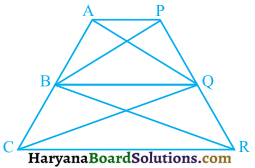
Solution:
Since ΔABQ and ΔPQB are on the same base BQ and between the same parallels AP and BQ.
∴ ar (ΔABQ) = ar (ΔPQB) …(i)
Again ΔBCQ and ΔQRB are on the same base BQ and between the same parallels BQ and CR.
∴ ar (ΔBCQ) = ar (ΔQRB) …(ii)
Adding (i) and (ii), we get
ar (ΔABQ) + ar (ΔBCQ) = ar (ΔPQB) + ar (ΔQRB)
⇒ ar (ΔAQC) = ar (ΔPBR).
Hence proved
Question 15.
Diagonals AC and BD of a quadrilateral ABCD intersect at O in such a way that ar (AOD) = ar (BOC). Prove that ABCD is a trapezium.
Solution:
In a quadrilateral ABCD, diagonals AC and BD intersect at O in such a way that
ar (ΔAOD) = ar (ΔBOC)
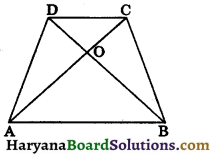
⇒ ar (ΔAOD) + ar (ΔAOB) = ar (ΔBOC) + ar (ΔAOB)
[adding ar (ΔAOB) on both sides]
⇒ ar (ΔABD) = ar (ΔABC)
Thus, ΔABD and ΔABC are on the same base AB and having equal area.
∴ AB || CD
Hence ABCD is a trapezium. Proved
![]()
Question 16.
In figure 9.29, ar (DRC) = ar (DPC) and ar (BDP) = ar (ARC). Show that both the quadrilaterals ABCD and DCPR are trapeziums.

Solution:
аr (ΔDRC) = ar (ΔDPC) …(1) (given)
So, ΔDRC and ΔDPC are on the same base DC and having equal area.
∴ RP || DC
⇒ DCPR is a trapezium.
and ar(ΔBDP) = ar (ΔARC) (given)
ar (ΔARC) = ar (ΔBDP) …….(2)
Subtracting (1) from (2), we get
ar (ΔARC) – ar (DRC) = ar (ΔBDP) – ar (ΔDPC)
⇒ ar (ΔACD) = ar (ΔBDC)
So, ΔACD and ΔBDC are on the same base DC and having equal area.
∴ DC || AB
⇒ ABCD is a trapezium.
Hence, DCPR and ABCD are trapeziums.
Hence proved